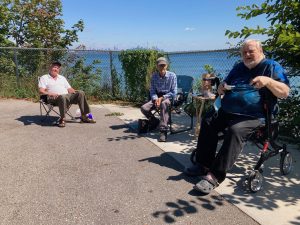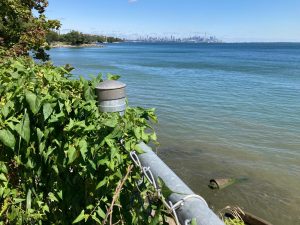Message from Graeme Decarie to all his MCHS classes; plus a note about the fact that in many contexts, diplomacy in communications enhances human agency
I’m pleased to share with you the following message from Graeme Decarie, a retired Concordia University history professor who taught history at Malcolm Campbell High School in Montreal in the early 1960s:
I’m having a terrible time with my computer which has gone wacky. But – I very much want to get in touch with my MCHS classes. However, my computer refuses to cooperate. I wrote to Bob [Carswell] about this but I’m not sure he got it. Would it be possible to send a note to all MCHS students to write to me at graemedecarie1@gmail.com
I hope I got that right. I’m having serious computer problems.
On another topic, at a previous post I’ve written a comment about human agency. I include the comment at the current post by way of bringing attention to it.
Demonstration of agency by residents when land use decisions are about to be made
The following text is from Note 9 at a previous post entitled:
The note begins with a Dec. 29, 2021 update which reads:
We are dealing with power relations. We are dealing with social pragmatics, and with non-verbal as well as verbal behaviour. I base these comments on several decades of involvement in focused efforts to influence decision making in a wide range of volunteer projects at the local, national, and international levels.
In the early years, I spent little time articulating what I was aware of, with regard to such topics. In the past decade, however, in particular when I’ve stopped to think about the nature of human agency, I’ve begun to write about things that have guided my behaviour in relation to power dynamics. In years past, I’d been applying such things without a lot of conscious thought.
It occurs to me that a point worth underlining is that in deputations related to land use decisions, the best way to approach communications is by maintaining a tone of level-headedness, diplomacy, and cordiality. That makes it easier for decision makers to make good decisions, in my anecdotal experience as an advocate and observer.
Expressions of anger and contempt may work well, as a way to channel and exploit anger, for populist politicians but in the representation of the interests of residents they are, in my view, counter-productive.
In terms of deputations I’ve seen at the City of Stratford and elsewhere, the most effective ones by far, when viewed from within the framework of power relations and outcomes, are the communications that are cordial and diplomatic. It’s been my observation that, as a general rule, the easiest request to turn down, the easiest representation to ignore, is the one that is characterized by anger and contempt.
These are my observations, based on my own anecdotal experience, which I share for whatever value they may have.
The broader issue is power relations. Or power dynamics. That is, who can cause what to happen, under what circumstances? This is a topic I’ve been thinking about since I was a child. When I was in Grade 4 at Cartierville School, I pondered the fact that Mrs. Findlayson, who was the principal, was the person who appeared to have the most power in the school. You could sense it when she came walking down the hall. I pondered what it meant, when a particular person has power in a given setting.

Cartierville School 1959-60 hockey team. In the front row, Tom Kuchlein is fourth from the right and Martin Kues is on the far right. Photo source: Tom Kuchlein
These are things that I think children figure out pretty quickly. As the years went by, I pondered how power dynamics make their presence known in everyday life. At first, I didn’t try to put into words what I was learning.
As the years went by, much later I settled (at least for now) on the concept of human agency, as a useful way to think about what goes on, say, when land use decisions are being made in cities (and rural settings) across Canada. I began to think about agency when I observed that some people have a lot of agency, and some have very little. I began to think: “What’s involved, in the demonstration of agency?”
In the past decade, through a combination of events, I’ve become particularly interested in land use as a topic that I can spend time pondering.
Prior to the past decade of thinking about land use issues, I spent 15 years in volunteer activities involved with community self-organizing.
Ways of seeing things vary from person to person
A related concept (in addition to the concept of agency) is the idea that individuals and groups operate in accordance with particular perceptual systems, or characteristic ways of seeing, which in turn are connected with related forms of language usage, within particular configurations of power relations.
I have been interested to learn, primarily through attending land use hearings in Toronto over the past decade, that sometimes power speaks its own language, whereby up is down, in is out, and big is small.

Left to right: Dan McPhail, Jaan Pill, Bob Carswell at parking lot of apartment building where Bob Carswell lives, Sept. 2, 2021. Jaan Pill photo
A corollary is that agency can be demonstrated in any of a wide range of ways, some of which are beneficial and some of which are harmful, depending on the vantage point of a given observer.
The current footnote is about how inspired I am regarding the history of Saraguay Woods, which I was delighted to have the opportunity to learn about over the past year.
At previous posts, accessible via this website’s search engine, I’ve described equally inspiring instances of residents, in locations elsewhere than Saraguay, who have also effectively demonstrated agency, in a most powerful and productive way.
Common elements in successful community self-organizing projects
All such efforts have things in common, in my anecdotal experience. You need an individual or core group of individuals with a vision, capable of bringing people together. You need to devote time to plan, prepare, consult, do research, investigate.
The work has to be spread out among many people, each with a strong sense of ownership of the project, as it’s usually too much for one or a handful to do on their own.
In my experience, with nonprofit organizations it’s vital to have a plan for leadership succession in place to ensure the project or organization has staying power. A culture of leadership succession is easy to set into place if the constitution and bylaws spell out clear provisions – such as term limits for senior leadership – to ensure leadership succession.
Otherwise, community groups come and go meaning that a community’s ability to represent its own interests is diminished. If the same group of leaders leads indefinitely, they grow old together without making provisions for a new leadership generation to emerge. Under such conditions when the longterm leaders fade away or pass away, the association is likely to pass from the scene as well, until a new generation comes along to start up a group from scratch.

Graeme Decarie, Aug. 6, 2016. Moncton, N.B. In an email about the photo, Graeme, who now lives in Ottawa, notes: “It doesn’t capture the lush glory of my hair.”
Many groups have inspired me in recent years. There are many such groups and projects including across the Greater Toronto Area and beyond. You can learn about them at this website.
I can add the name of an individual who demonstrated agency in a huge way was Allan McDougall. A Feb. 20, 2019 Vancouver Sun obituary is entitled: “Obit: Canadian book legend Allan MacDougall dies at 71: He landed the Canadian rights to J.K. Rowling’s Harry Potter books, one of the most astute deals in the history of Canadian publishing.” Allan, who grew up on a Saraguay estate, was in my Grade 4 class at Cartierville School in the 1950s. I remember him as a good-natured student, with a great sense of humour.
Long Branch, Lakeview, Port Credit, Stratford, and Niagara on the Lake
In Long Branch, the Long Branch Neighbourhood Association was launched some years ago starting with a preliminary survey of residents and a series of pre-launch meetings. The name of the association is the outcome of a survey question where residents chose from a list of names that had emerged from previous discussions.
Starting from the earliest planning stages, it was established that meetings would be devoted to the next steps in the organizing process, rather than to ‘ventilating.’ Complaining about things demonstrates a lower level of agency; deciding instead what to do next, in response to the challenges a community faces, is the better option by far.
The Long Branch Neighbourhood Association (LBNA) demonstrates that when members have a strong sense of ownership of an association, then they are motivated to support its work in every possible way. The sense of ownership matters hugely.
The LBNA has in recent years played a key role in a significant City of Toronto pilot project involving development of the Long Branch Character Guidelines. The Guidelines have served to guide some aspects of land use decision making in Long Branch, at the Toronto Local Appeal Body, as I understand, which is a considerable achievement.
As a result of a great deal of work, which I’ve documented at previous posts, a great number of people put together the Long Branch Character Guidelines. This is the outcome of a trajectory that began with the launch of the LBNA and that has continued since that time. Prior to the launch of the LBNA, another local association (focusing exclusively on the Long Branch neighbourhood located to the south of Lake Shore Blvd. West) had been in place, but it was more narrowly focused (pretty much solely on opposition to lot-splitting) and had decidedly less of an uptake among residents.
Although I live in Stratford, I am an affiliate (non-voting) member of the Long Branch Neighbourhood Association and strongly support its work behalf of residents of Long Branch and other Toronto neighbourhoods.
I’ve also written at this website about what Jim Tovey, John Danahy, and many others have achieved in getting development processes underway along the Mississauga waterfront. Projects now proceeding in Lakeview and Port Credit originated in a planning environment in which community interests were strongly taken into account. I’ve also written about how human agency has been strongly and productively expressed by community groups in Stratford and Niagara on the Lake.
A recent post about Stratford focuses on a current land use issue in that city; the post includes a link to an online video of a recent meeting of the city’s Heritage and Planning Committee. A presenter at the meeting noted that issues related to climate change are inseparable from current land use planning issues in a city such as Stratford. The online video also includes comments from several sources that a set of neighbourhood character guidelines would come in handy when future development proposals are presented for consideration by the city council.
Stratford residents have also done well in ensuring that a proposal for a floating glass plant was withdrawn some time back. The original plan, engineered by the city council, was to push the project ahead, without public consultation. When residents heard about the intended bypassing of community consultation, they let their views be known.
More recently, the city has been making what appears to be good progress in moving a project forward, which focuses on the restoration and repurposing of Stratford’s Cooper Site, a huge railroad repair shop that has sat empty for many years.
In Niagara on the Lake, a key current issue concerns whether or not the Ontario Heritage Act has enough clout, in practice, to ensure that a historic property, the town’s Randwood Estate, which has been designated under the Act, is actually saved from destruction. As well, anecdotal evidence indicates that a set of neighbourhood character guidelines would come in handy in guiding future decisions involving land use in the Town of Niagara on the Lake.
Agency demonstrated by citizens of First Nations of North America
When I think about local history in Quebec, such as in relation to the Back River, Saraguay, and the Lake of Two Mountains, I also think about events – about what some observers label as the Oka Crisis – in Oka, Quebec, some years ago.
The expression of agency by Indigenous advocates in Oka and elsewhere, in response to settler colonialism inspires me tremendously.
When I think about all land use issues, now and in the past, I also think of the one big land use issue that subsumes – that is, that, in a sense, consumes – all other such issues: namely, the issue of the climate crisis. The agency that humanity has demonstrated with regard to ordering life on the planet since the Enlightenment has had a positive side and, of course, a side that is acutely problematic.
Regarding this topic, an Oct. 18, 2021 CBC editor’s note is entitled: “The planet is changing. So will our journalism: CBC News commits to doing even more climate change journalism.”
An excerpt reads:
The impact of climate on our changing planet may be the most pressing story of our time.
It is an environmental story, yes, but it’s also about health, the economy, jobs, energy, food, water, security, geopolitics, justice and equity. No sector will be spared its impact. Climate change will define every aspect of our lives and those of generations to come.
The consequences of increased greenhouse gas emissions from human activity should be a surprise to no one: According to projections by the Intergovernmental Panel on Climate Change (IPCC), Canada will experience increasingly warmer temperatures and more extreme highs; sea levels will rise on most of our coasts, causing greater coastal flooding and erosion; ocean acidification will increase; this country’s glaciers, permafrost and snow cover will decrease; hurricanes, storms and dust storms will intensify.
Our own research tells us that Canadians want to understand what’s happening (the facts and the science) and learn more about what can be done. There is a hunger for constructive solutions.



Dec. 29, 2021 test message to Graeme Decarie’s email address (see above):
Jaan Pill: I’m trying out your email address. Hoping this message reaches you.
Best,
Jaan
Graeme Decarie: It reaches me. And I’m beautiful.
graeme
At this post I refer to the situation in Oka, Quebec in the summer of 1990, a topic discussed at previous posts.
The events are known variously as the Oka Crisis and the Kanesatake Resistance.
A valuable overview regarding the power dynamics associated with the events in Oka, and the related land use history, is provided in a book entitled: Freedom and Indigenous Constitutionalism (2016).
A blurb reads:
Demonstrating how Canada’s constitutional structures marginalize Indigenous peoples’ ability to exercise power in the real world, John Borrows uses Ojibwe law, stories, and principles to suggest alternative ways in which Indigenous peoples can work to enhance freedom. Among the stimulating issues he approaches are the democratic potential of civil disobedience, the hazards of applying originalism rather than living tree jurisprudence in the interpretation of Aboriginal and treaty rights, American legislative actions that could also animate Indigenous self-determination in Canada, and the opportunity for Indigenous governmental action to address violence against women.
Also with regard to events in Oka in the summer of 1990, a Nov. 19, 2021 CBC article is entitled: “How the legacy of the Royal Commission on Aboriginal Peoples lives on, 25 years later: While its recommendations were largely ignored, the sweeping report had profound impact in legal community.”
An excerpt reads:
Over four years, the commission travelled to 96 communities and held 178 days of public hearings to produce a comprehensive five-volume report that essentially outlined a 20-year roadmap for bettering the lives of Indigenous people in Canada.
And the cost of peace — as Chartrand says the government viewed it — was a recommendation for a $30-billion investment in Indigenous communities over a 20-year span.
The commissioners argued investing this money immediately to eliminate gaps in areas like education, health care, nation-building, justice and child care would actually save the federal government money 20 years down the road.
In other words, sovereign, healthy communities would cost a whole lot less due to the initial, upfront investment.
But that $30-billion figure, along with the constitutional changes needed to achieve some of the reforms, led the government to reject the funding’s implementation within an hour of the report being tabled.